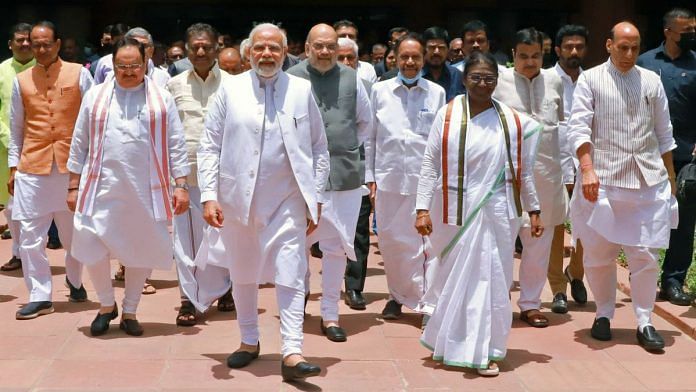
Thank you dear subscribers, we are overwhelmed with your response.
Your Turn is a unique section from ThePrint featuring points of view from its subscribers. If you are a subscriber, have a point of view, please send it to us. If not, do subscribe here: https://theprint.in/subscribe/
The elevation of Droupadi Murmu as the President of India, the first tribal woman to be elected to the position, represents an aspirational moment for the marginalised Adivasi communities who operate at the margins of “the modernising (postcolonial) State”. The broad Adivasi category has been studied as the “footloose labourers” disadvantaged at the behest of the alliance between the “modern State” and the financial oligarchy.
Adivasi identity formation is socially integral to constructing a unified Hindu identity distinct from the secular-progressive framework that sees indigeneity as central to the politics of difference. This tension between the capital-led developmental State and socio-ideological imperatives could pose significant challenges to the ruling BJP in times to come.
BJP and the critique of the Subaltern:
The rise of the BJP as a dominant force challenged the hitherto existing consensus on the limits of Hindutva. What the BJP managed to achieve were, one, to bridge regional-cultural identities with the dominant Hindu identity through diverse localised cultural strategies; two, to bring what Nancy Fraser refers to as “participatory parity” by expanding representation with the simultaneous critique of discrimination and hierarchy within the subaltern groups… for example, expanding political representation to non-Yadav and non-Jatav social groups in the so-called Hindi heartland; three, to integrate the capital-led development discourse with social justice.
Bahujan politics of the 80s and the 90s brought the question of redistribution with representation. The broad social coalition that brought Mandal parties to power had critiqued the imbalance between claims of equality and the post-colonial administrative State. The Bahujan upsurge of the 80s was a step towards participative parity with an expectation of solidarity beyond patronage. It combined democratic assertion with political power.
The introduction of neoliberal reforms accentuated the contradictory forces of social change – Mandal and Hindutva mobilisation of the 90s. Neoliberal reforms receded the question of redistribution at a time when social recognition became the grammar of politics. While street-based extra-institutional democratic assertion characterised Bahujan politics (Jungle Raj), neoliberal forces brought a distinct social ethic of individualism confronting violent assertion. Redistribution with violence got replaced with recognition without inclusion within capital-led development discourse. The disjunction between development and inclusion is internal to the neoliberal process.
The BJP’s rise exposed tension between sectarian demands and the universal development discourse. It critiques the absence of a development narrative within the Bahujan discourse while simultaneously expanding the discourse of social justice through political representation. The New Education Policy for example demands submission of autonomy for “merit” and “choice” for centralization. The attempt to dilute the Indian Forest Act illustrates the absence of discourse of redistribution in the development narrative while expanding representation to the tribal social groups.
Hindu or Adivasi or both?
The elevation of Murmu could usher in the aspirational moment for the tribal population across India and enable setting the social narrative right for the BJP to trounce the Bahujan-Congress opposition. Yet, the challenges it could pose to the dominant BJP need to be understood.
Draupadi Murmu’s presidency represents a watershed moment in the post-Bahujan phase of politics as new social groups are articulating demands. Murmu’s elevation to the presidency offers an institutional channel for the tribal population to realise demands that hitherto went unaddressed. For example, there has been a long-standing demand for the recognition of Sarna as distinct from Hinduism. With Murmu at the helm, the aspirations are at the peak to realise this demand.
The identity formation or the social engineering by the RSS, a socio-cultural organisation, seeks to include Adivasi within the umbrella discourse of Hinduism by presenting overlapping elements of worship between the tribals and the ‘mainstream’ Hindus in terms of the significance of nature. What is particularly distinctive about this expansive construction of Hindu identity by the RSS is to present Hinduism as indigenous and diverse despite its exclusionary/hierarchical characters. It is, in a way, an acknowledgement of ‘Adivasi’ distinctiveness from Brahmanical Hindu emphasis on scriptural-ritualistic hegemony.
This process of competing for identity formations/claims could fragment the dominant Hindu social base and open up spaces for the opposition to fill. The critique of capital is insufficient as sectarian tensions operate outside the limits of the market. On the social front, critique of Brahmanism comes across as an assault on the “Hindu unity”. Critique of caste as a ritual-based hierarchy holds less credibility due to changes within the Hindu social organisation. The secular-universal development discourse is being combined with the sectarian discourse of Hindutva.
The axis of social conflict has moved from the elite-subaltern frame to the intra-subaltern frame. Hindutva critiques subaltern violence while building “violent fraternity” against the “common enemy” of Muslims. While the BJP benefitted from the “rightward shift” of the Dalit-Bahujans from claims for redistribution to recognition-representation by offering cultural strategies, it would be a challenge to consolidate tribal identity behind the BJP juggernaut.
These pieces are being published as they have been received – they have not been edited/fact-checked by ThePrint.


COMMENTS